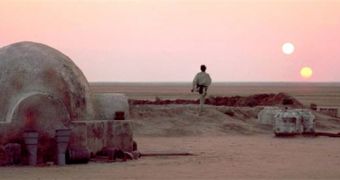It's a common sight in numerous science fiction stories and movies: a planet with two suns (often of drastically different colors) producing double shadows, multiple sunrises and sunsets, and other exotic phenomena that would appear utterly alien to us Earthlings, like Luke Skywalker's home planet, Tatooine.
While substantial liberties are often taken with such stories, the basic underlying scenario is scientifically sound, and in fact reflects a basic reality.
Astronomers might not have to search a galaxy far, far away after all to find a world with double sunsets like Luke Skywalker's home planet. A new study suggests the universe is filled with them.
In fact, 2/3 of stars like our sun have at least one stellar companion. Astronomers have theorized that planets could form with little trouble in two-star systems, called binaries, despite the more complex gravitational tugging.
The evidence is supported by observations made using NASA's Spitzer Space Telescope, that have found twin-star systems just as likely to be surrounded by dusty debris disks as ones with only a single star, debris disks that are made up of asteroid-sized rock chunks and other material that could be leftovers of planets that have formed in the system.
An example is the discovery of a planet orbiting around Gamma Cephei, a moderately bright star located near Polaris and currently visible in our northwestern sky during the evening hours. The Gamma Cephei system comprises a primary star that is somewhat larger than our sun, together with a smaller companion star that's about half the sun's size orbiting the primary at the approximate distance of the planet Uranus in our system. The planet appears to be about twice the size of Jupiter, and orbits the primary star every 2 1/2 years in an orbit that corresponds to that of the asteroid belt in our solar system.
The new observations further enforced the idea that "There appears to be no bias against having planetary system formation in binary systems," according to study leader David Trilling of the University of Arizona. "There could be countless planets out there with two or more suns."
Furthermore, the researchers found that about 40 percent of the binary systems they looked at had debris disks. This frequency is a bit higher than that for a comparable sample of single stars and suggests planets are at least as common around binary stars as they are around single stars.
So, it could be possible that "A human gazing at a double sunset on a world with two Suns like Skywalker's Tatooine might not find the scene so alien after all, Trilling said. "It would be kind of like what you see on Earth, but with an extra Sun following in the sky," he said. "Maybe it's a little hotter during the day."

 14 DAY TRIAL //
14 DAY TRIAL //